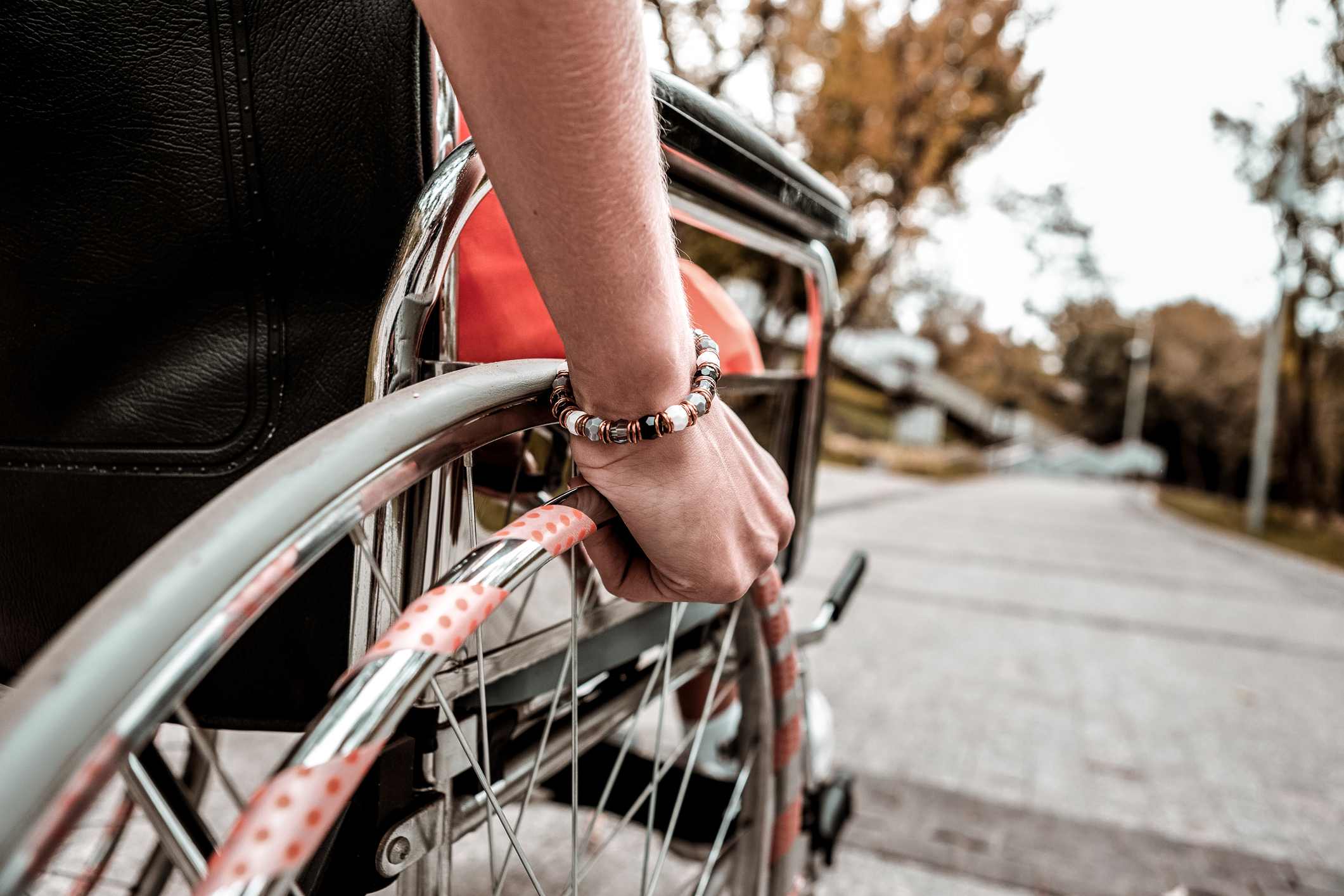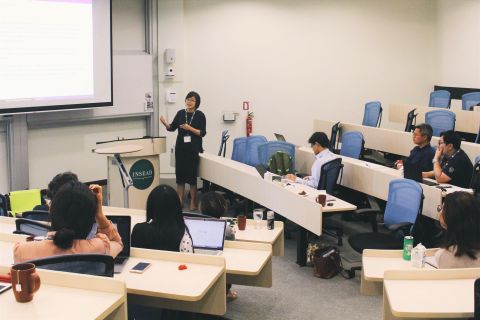
By Alvin Lee
SMU Office of Research & Tech Transfer – A wheelchair can help to improve the quality of life (QOL) of those with physical disabilities. With wheelchairs providing the mobility that would otherwise be denied to them, wheelchair users (WCUs) gain access to increased participation, which the World Health Organization’s International Classification of Functioning, Disability and Health (WHO-ICF) defines as “a person's involvement in a life situation, [which] represents the societal perspective of functioning.”
While research has been done to quantify the difference a wheelchair makes with regard to participation, the results are based mostly on self-reported data which may be prone to over- or under-estimation. So when Assistant Professor Tan Kar Way at the SMU School of Information Systems (SIS) came across a project that involved identifying barrier-free paths – hence the GPS points – taken by WCUs, she decided to rope in third-year SIS undergraduate student Yin Yukun to do something different.
“Our project stemmed from a project called SmartBFA[1](Smart Mobility and Accessibility for Barrier-Free Access),” Professor Tan told the Office of Research and Tech Transfer, referring to the collaboration helmed by SMU Assistant Professor of Information Systems Tan Hwee Xian in conjunction with the non-profit organization – Trampolene Limited. [Editor’s note: All references of “Professor Tan” hereinafter refers to SMU Assistant Professor Tan Kar Way].
“The main objective of the SmartBFA project was to design a scalable and sustainable system that can collect, classify and determine accessible point-to-point routes to address interconnection gaps in first- and last-mile BFA paths for persons requiring barrier-free access (such as wheelchair users). Mounting sensors on wheelchairs is one of the ways to gather data for this purpose.”
“Our project, building on the idea of the BFA paths for WCUs, looks into the social participation of this group of users. They say that they do participate – so are they really participating?”
Results of the study
As there is no consensus on the definition of “social participation”, Professor Tan and Yin settled on WHO-ICF’s definitions for the term, which described the first level as: “interacting with others without doing a specific activity with them”. The other levels – “doing an activity with others”, “helping others”, and “contributing to society” – were hard to measure objectively and could not be reflected objectively via GPS data captured basd on the wheelchair's movements. Performance was therefore measured by how often the WCU ventured outside of his or her home.
“Because we wanted to compare capacity [to participate] and the actual performance,” explained Professor Tan, who is the Programme Director for SMU’s BSc (IS) Smart-City Management & Technology Major, “we took the self-reported numbers as capacity. If the volunteer says, ‘I go out three times a week’, then that is taken as his capacity – the number of times that he can go out.”
The 70 volunteers, on whose anonymised data the project was built, self-reported their level of participation on a scale of 1 to 5 based on six factors: 1. Social; 2. Family; 3. Economic; 4. Community life; 5. Independence in daily living; and 6. Willingness to participate in out-of-home activities.
Using k-means clustering algorithm and implemented in Python scripts, the differences between the WCUs’ self-rated and actual performances were analysed and divided into four clusters:
- Fairly independent, able to move around without assistance, willing to participate in social activities but lower than average self-rated participation levels;
- Highly reliant on support from caregivers to go about daily life, somewhat less willing to participate in social activities;
- Independent but unwilling to participate in social activities; and
- Independent like the first cluster but self-rated participation levels are high.
“We noticed that the people who scored [themselves] lower in terms of capacity were actually more honest,” Yin explained, pointing to WCUs in clusters 2 and 3 who went out as often as they said they could. In contrast, those in cluster 4 had the highest gap between self-rated performance and actual performance. “The people who said they have high capacity to participate in social activities may not actually go out as often as they have reported.”
Learnings and applications
Those in cluster 1 recorded the second highest performance-capacity gap. Compared to cluster 4 WCUs who were generally satisfied with their participation level despite recording the greatest performance-capacity gap, cluster 1 WCUs were dissatisfied. Professor Tan pointed out what could be done for them.
“One of the most valuable lessons we learnt in this project is the profiles of the wheelchair users,” she pointed out while focusing on those in cluster 1. “The characteristics of the profiles of the WCUs may potentially help social workers or medical (psychology) professionals to provide advice to the WCUs or identify potential issues such as depression or social isolation.”
The general age profile of the volunteers also presented the researchers with opportunities for future research. With 60 percent of respondents being 50 years or older, Yin shared that the study could potentially be used as the groundwork to gain better insights into our aging population, and improve the ecosystem in which they reside.
For example, given that the number of Singaporeans above the age of 60 with dementia is expected to rise to 80,000 by 2030, the use of real-time GPS tracking could be explored to alert family members or social workers of an elderly person, WCU or otherwise, wandering beyond a predefined virtual geofence.
“The current data makes it possible for us to map out their life space,” Yin elaborated, referring to places frequented every day. “They might potentially be suffering from dementia if they're [wandering] and no longer attached to what is familiar to them anymore. If you can map their movement patterns over time, you can detect irregularities in it.”
Professor Tan highlighted privacy issues with regard to whether WCUs want to be tracked, and how to put together “a compelling proposition for users to the benefits of location tracking”, especially those who have been identified as ‘high-risk’. Those who are agreeable can also use GPS tracking for medical purposes.
“After people have had their surgeries (e.g. knee cap replacement), they are supposed to go home and continue moving around,” explained Professor Tan. “They can't move too much, nor can they move too little. If they move too much, the surgery becomes futile; if they move too little, they cannot recover.
“When they come back for a [medical] review, they’ll be asked, ‘Did you move about?’ ‘Oh yes, yes, I did.’ So how much is true and how much is untrue? This is a potential application which I hope to work with a healthcare institution on to see if there is research potential in that area.”
[1] This project is funded by Tote Board Enabling Lives Initiative Grant and supported by SG Enable.
Back to Research@SMU May 2019 Issue
See More News
Want to see more of SMU Research?
Sign up for Research@SMU e-newslettter to know more about our research and research-related events!
If you would like to remove yourself from all our mailing list, please visit https://eservices.smu.edu.sg/internet/DNC/Default.aspx

